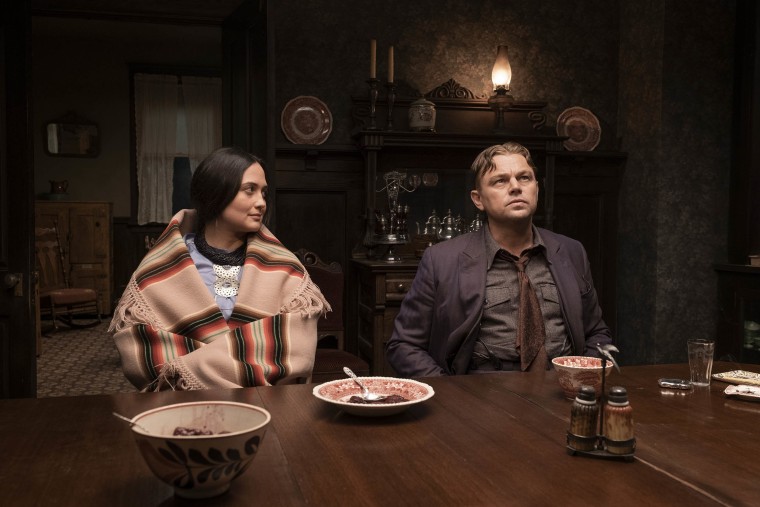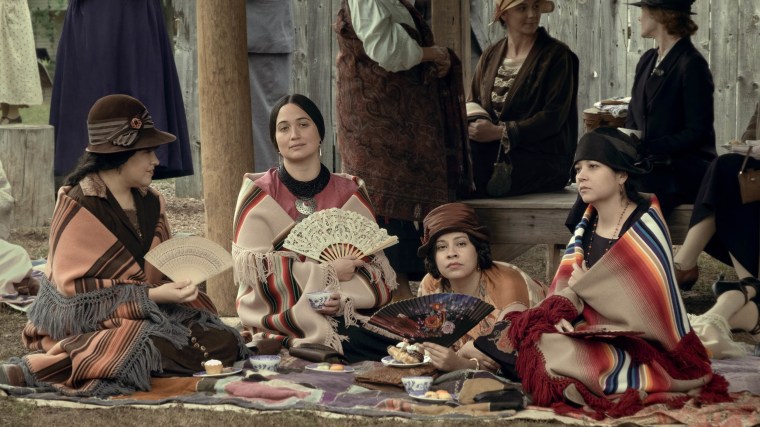Warning: Spoilers ahead for “Killers of the Flower Moon”
“Killer of the Flower Moon” is a riveting and tragic look at the real-life murders of members of the Osage Nation.
Directed by Martin Scorsese and based on David Grann’s 2017 book, “Killers of the Flower Moon: The Osage Murders and the Birth of the FBI,” the drama centers around World War I vet Ernest Burkhart (Leonardo DiCaprio) whose cattle-farming uncle, William “King” Hale (Robert De Niro), convinces him to marry wealthy Osage Nation member Mollie Kyle (Lily Gladstone) to gain control of her and her family’s oil money.
Osage Nation members became some of the richest people in the world after oil was discovered on their land. But in the 1920s, many were murdered or became suspiciously ill, including Mollie's sisters. This time is known as the Reign of Terror.
Scorsese worked closely with Osage Nation members to bring the heartbreaking true story to life, and chose a distinct ending to conclude “Killers of the Flower Moon.”

How does 'Killers of the Flower Moon' end?
As the movie unfolds it becomes clear that Ernest, his uncle and brother are behind the attacks, manipulating other settlers into doing their bidding.
“Killers of the Flower Moon” ends with Ernest and Hale being targeted by the FBI for the murders of members of the Osage Nation.
Scared and seemingly having a change of heart, Ernest, who had three children with Mollie, decides to testify against his uncle. As Mollie discovers that her husband and his family were behind the killings of her sisters, she wonders if Ernest had a hand in her illness.
As the case goes to court, Mollie, who was diabetic, asks Ernest if he had been mixing anything, potentially poison, into her insulin shots, causing her to almost die.
Ernest lies and tells her he did not harm her in any way, but their trust has been broken. As she walks away, the scene transitions with an unexpected ‘20s or '30s radio show with actors and musicians playing out on stage the results of Ernest and his uncle William Hale's case.
It shows a nicely-dressed audience listening as an all-white cast, in an upbeat manner, reading lines from the court case as it transmits over the airwaves, and wrapping up the characters' conclusions.
But there is one surprise element, where Scorsese himself walks on stage and solemnly reads Mollie's real-life obituary. The short obit has no mention of the murders of her family and the court case, acting as if nothing of relevance happened in her life.
Did the radio show in ‘Killers of the Flower Moon’ happen in real life?
In his book, Grann explains that in 1932, the FBI began working with radio program “The Lucky Strike Hour” to dramatize its cases. One of the first episodes was based on the Osage Nation murders.
J. Edgar Hoover, former director of the FBI, requested one of his agents write fictional scenes that were shared with the radio show’s producers.
Osage Nation Congress member Brandy Lemon, who served as a consultant for the movie, tells TODAY.com that the radio show is significant in the film because showed how the Osage's story was initially shared across the U.S.
"They talked about us like we didn’t matter."
Brandy lemon on the radio show about the reign of terror
“That was an actual radio show that occurred over 100 years ago. They recreated it,” she says. “And they talked about us like we didn't matter. Like just in passing, ‘Oh, by the way up in Osage Nation reservation, the Burkharts are going to jail and it was over,’ and that was hard to take.”
Why did ‘Killers of the Flower Moon’ end with a radio show?
Lemon understands if the ending “catches some folks off guard.”
“When you visit with people about it, they’re like, ‘Why would he do that?’” she says, “Because that’s how we were treated and that’s true depiction of what happened.”
Grann, on his end, also tells TODAY.com that while he didn't discuss the ending of Scorsese's cameo with the director specifically, he believes Scorsese wanted to show beyond what happened beyond a title card with information.

“I think he wanted to show how history gets told or mistold, how it kind of radiates out into culture and then ... can be warped,” Grann says.
"It was a point I tried to really make in the book, as well in mentioning that radio play — is how the Bureau (of Investigation), but also how those in power, can manipulate the way history is told and use history for their own purposes, and leave out or distort what really happened.”